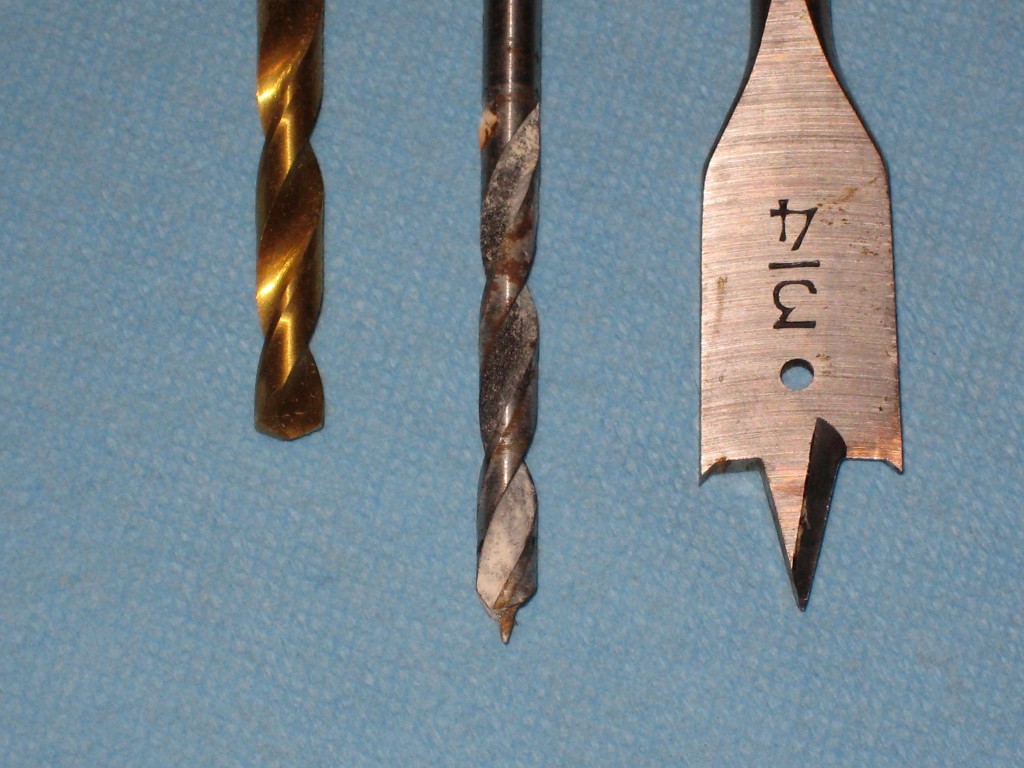
There’s a drill bit made for just about every scenario, and it’s important to choose the right drill bit for your project. Selecting the right bit makes jobs safer, easier, and ensures your drill bit will last. Here is a reference guide for wood boring / cutting drill bits. For a more complete list, Wikipedia has a rather extensive drill bit article.
Drill Bit Materials
Drill bits are made from different materials, each with different characteristics.
- Carbon Steel Bits – Carbon Steel bits are inexpensive but have relatively short lifespans. They resist heat poorly and so need to be sharpened frequently.
- High Speed Steel Bits (HSS) – Are a step above Carbon steel drill bits. HHS bits resist heat much better and subsequently, maintain a sharp edge longer.
- Titanium Coated – These coated bits will last even longer than HHS bits. Look for Titanium Aluminum Nitride (TiAN) or Titanium Carbon Nitride (TiCN) as these are the best. The downside with coated bits is that they can’t be properly sharpened because that would remove the coating. But if it needs sharpening, the coating may be gone already.
- Carbide-Tipped – Carbide-tipped bits will stay sharper than even Titanium coated bits. They are also more expensive. Carbide-tipped bits dissipate heat quickly but can chip if not used carefully.
- Cobalt Bits – Cobalt bits are very hard and keep a sharp edge even at higher temperatures. They are typically used for drilling into stainless steel and other metals.
Wood Drill Bits
One of the most common tasks for any DIYer is drilling a hole. These are the drill bits suitable for drilling into wood.
- Twist Bit – Twist bits are some of the most common drill bits available. You can find them in many different sizes and materials. The front edge cuts into the material and the flutes channel away debris. Twist bits can be used for drilling in plastic, wood and light metal.
- Brad Point Bit – Brad Point (a.k.a. Spur Point / Lip and Spur) bits look similar to Twist bits except they have a centre brad and sharp corners. The brad pushes into the wood, anchoring the bit, allowing you to drill a precise hole. Again, these bits are effective in wood, plastic, and soft metals.
- Spade Bit – Spade bits (a.k.a. Paddle / Flat) bits are great for boring large, rough holes. They are flat with a long spur in the center. Spade bits come in sizes 1/4″ through 1-1/2″. Fred wrote a great post all about Spade bits. Check it out for more details.
- Auger Bit – Auger bits are ideal for boring deep, large holes. It has deep flutes for chip removal and a self-feeding screw tip that pull this bit into the wood.
- Adjustable Wood Bit – The Adjustable Wood (a.k.a Expansive) bit has a small center pilot followed by an adjustable cutting edge. The edge can be centered for smaller holes, or slide out for larger holes and locks in place with a set screw. This bit is very versatile and provides uncommon bit sizes.
- Hole Saw – A hole saw looks just like it sounds. It’s a circular tube with saw teeth and a centre pilot drill. It’s used for boring large diameter holes like door knob holes. They usually range from 1/2″ to 6″ diameters.
What do you think? Any good info to add?








Good information and you covered it very well! The only bit that I use that you didn’t mention is a bit used for making a hole in glass. I don’t however use them that often for glass rather I use that type of bit for making holes in tile. Very well explained and presented post! Thanks, Scott Your Online Handyman
@Onlinehandyman, I’ve used a few ceramic tile bits before – didn’t realize they were also good for drilling glass… (Ethan’s post was on ‘wood drill bits’ and hence why they weren’t included…)
You are so right Fred, my mistake and it is even in the headline.
I’ve been using the Bosch Multi-Construction Bits for a few months now and these are in a class of their own. Metal, wood, ceramic, just about anything! They are extremely sharp and go through all wood like butter.
Only two downfalls with the bits. They don’t come in enough sizes and they don’t do well in stained glass. (in regular window glass they work fine)
I’d add a set of Forstner bits as well. They are great for precision holes especially if you start using a drill press.
Good addition Todd! I don’t have a drill press so I’ve never had the chance to use Forstner’s before.
You’ve also got crazy wood bits like Irwin’s Speedbor MAX, which are similar to a Forstner bit that had a baby with a Gremlin. Not the AMC Gremlin, but the kind you’re not supposed to feed after midnight.
Appreciate the info on materials.